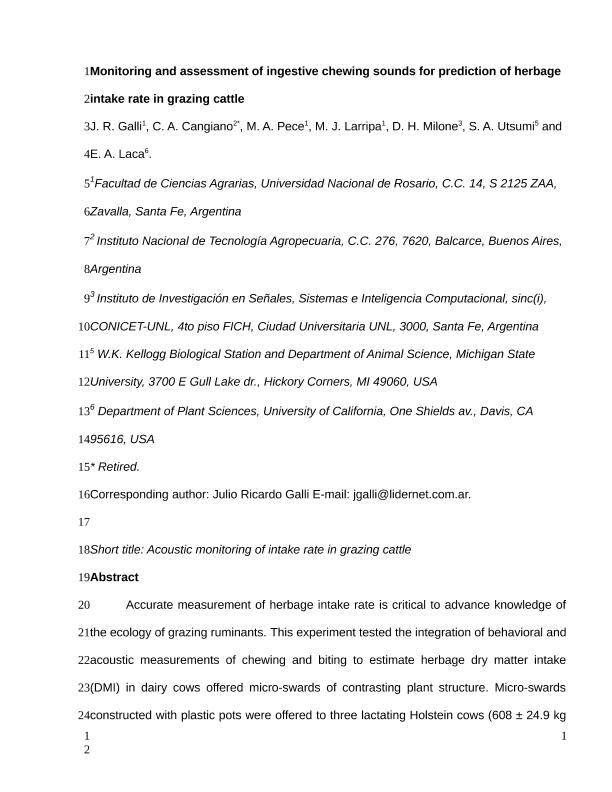Mostrar el registro sencillo del ítem
dc.contributor.author
Galli, Julio Ricardo

dc.contributor.author
Cangiano, Carlos Alberto

dc.contributor.author
Pece, M. A.
dc.contributor.author
Larripa, M. J.
dc.contributor.author
Milone, Diego Humberto

dc.contributor.author
Utsumi, S. A.
dc.contributor.author
Laca, E. A.
dc.date.available
2018-06-07T21:04:33Z
dc.date.issued
2017-10
dc.identifier.citation
Galli, Julio Ricardo; Cangiano, Carlos Alberto; Pece, M. A.; Larripa, M. J.; Milone, Diego Humberto; et al.; Monitoring and assessment of ingestive chewing sounds for prediction of herbage intake rate in grazing cattle; Cambridge University Press; Animal; 12; 5; 10-2017; 973-982
dc.identifier.issn
1751-7311
dc.identifier.uri
http://hdl.handle.net/11336/47802
dc.description.abstract
Accurate measurement of herbage intake rate is critical to advance knowledge of the ecology of grazing ruminants. This experiment tested the integration of behavioral and acoustic measurements of chewing and biting to estimate herbage dry matter intake (DMI) in dairy cows offered micro-swards of contrasting plant structure. Micro-swards constructed with plastic pots were offered to three lactating Holstein cows (608±24.9 kg of BW) in individual grazing sessions (n=48). Treatments were a factorial combination of two forage species (alfalfa and fescue) and two plant heights (tall=25±3.8 cm and short=12±1.9 cm) and were offered on a gradient of increasing herbage mass (10 to 30 pots) and number of bites (~10 to 40 bites). During each grazing session, sounds of biting and chewing were recorded with a wireless microphone placed on the cows? foreheads and a digital video camera to allow synchronized audio and video recordings. Dry matter intake rate was higher in tall alfalfa than in the other three treatments (32±1.6 v. 19±1.2 g/min). A high proportion of jaw movements in every grazing session (23 to 36%) were compound jaw movements (chew-bites) that appeared to be a key component of chewing and biting efficiency and of the ability of cows to regulate intake rate. Dry matter intake was accurately predicted based on easily observable behavioral and acoustic variables. Chewing sound energy measured as energy flux density (EFD) was linearly related to DMI, with 74% of EFD variation explained by DMI. Total chewing EFD, number of chew-bites and plant height (tall v. short) were the most important predictors of DMI. The best model explained 91% of the variation in DMI with a coefficient of variation of 17%. Ingestive sounds integrate valuable information to remotely monitor feeding behavior and predict DMI in grazing cows.
dc.format
application/pdf
dc.language.iso
eng
dc.publisher
Cambridge University Press

dc.rights
info:eu-repo/semantics/openAccess
dc.rights.uri
https://creativecommons.org/licenses/by-nc-nd/2.5/ar/
dc.subject
Acoustic Analysis
dc.subject
Chew-Bite
dc.subject
Chewing
dc.subject
Ingestive Behavior
dc.subject
Ruminants
dc.subject.classification
Ciencias de la Computación

dc.subject.classification
Ciencias de la Computación e Información

dc.subject.classification
CIENCIAS NATURALES Y EXACTAS

dc.title
Monitoring and assessment of ingestive chewing sounds for prediction of herbage intake rate in grazing cattle
dc.type
info:eu-repo/semantics/article
dc.type
info:ar-repo/semantics/artículo
dc.type
info:eu-repo/semantics/publishedVersion
dc.date.updated
2018-05-31T18:19:13Z
dc.journal.volume
12
dc.journal.number
5
dc.journal.pagination
973-982
dc.journal.pais
Reino Unido

dc.journal.ciudad
Cambridge
dc.description.fil
Fil: Galli, Julio Ricardo. Universidad Nacional de Rosario; Argentina
dc.description.fil
Fil: Cangiano, Carlos Alberto. Instituto Nacional de Tecnología Agropecuaria. Centro Regional Buenos Aires; Argentina
dc.description.fil
Fil: Pece, M. A.. Universidad Nacional de Rosario; Argentina
dc.description.fil
Fil: Larripa, M. J.. Universidad Nacional de Rosario; Argentina
dc.description.fil
Fil: Milone, Diego Humberto. Consejo Nacional de Investigaciones Científicas y Técnicas. Centro Científico Tecnológico Conicet - Santa Fe. Instituto de Investigación en Señales, Sistemas e Inteligencia Computacional. Universidad Nacional del Litoral. Facultad de Ingeniería y Ciencias Hídricas. Instituto de Investigación en Señales, Sistemas e Inteligencia Computacional; Argentina
dc.description.fil
Fil: Utsumi, S. A.. Michigan State University; Estados Unidos
dc.description.fil
Fil: Laca, E. A.. University of California at Davis; Estados Unidos
dc.journal.title
Animal

dc.relation.alternativeid
info:eu-repo/semantics/altIdentifier/doi/http://dx.doi.org/10.1017/S1751731117002415
Archivos asociados
